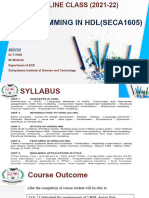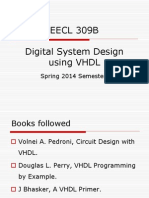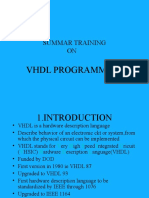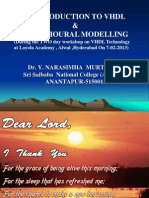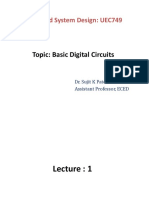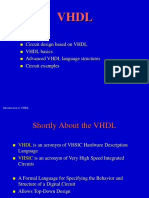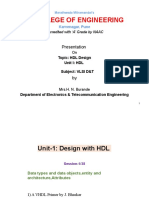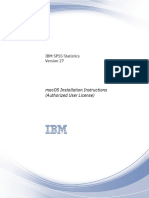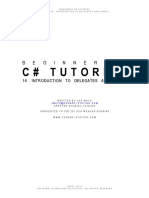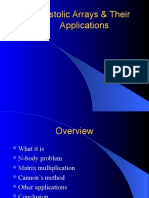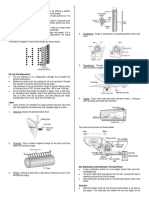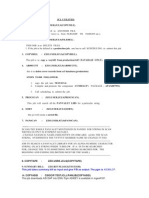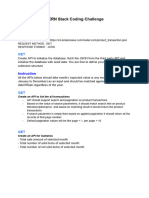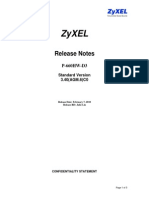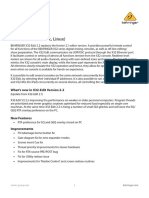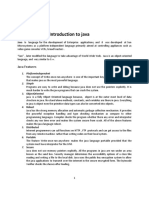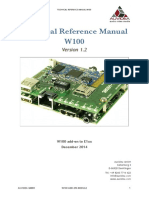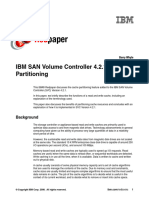CME 4456
RECONFIGURABLE COMPUTING
VHDL
Şerife YILMAZ 1
Languages Other Than VHDL
VHDL: VHSIC (Very High Speed
Integrated Circuit) Hardware Description
Language
– Not the only hardware description language
2
ABEL
ABEL
– Simplified HDL
– PLD language
– Dataflow primitives, e.g., registers
– Program XILINX FPGA
3
ALTERA
ALTERA
– Created by Altera Corporation
– Simplified dialect of HDL
4
AHPL
AHPL: A Hardware Programming
Language
– Dataflow language
– Implicit clock
– Does not support asynchronous circuits
– Fixed data types
– Non-hierarchical
5
CDL
CDL: Computer Design Language
– Academic language for teaching digital systems
– Dataflow language
– Non-hierarchical
– Contains conditional statements
6
CONLAN
CONLAN: CONsensus LANguage
– Family of languages for describing various
levels of abstraction
– Concurrent
– Hierarchical
7
IDL
IDL: Interactive Design Language
– Internal IBM language
– Originally for automatic generation of PLA
structures
– Generalized to cover other circuits
– Concurrent
– Hierarchical
8
ISPS
ISPS: Instruction Set Processor
Specification
– Behavioral language
– Used to design software based on specific
hardware
– Statement level timing control, but no gate
level control
9
TEGAS
TEGAS: TEst Generation And Simulation
– Structural with behavioral extensions
– Hierarchical
– Allows detailed timing specifications
10
TI-HDL
TI-HDL: Texas Instruments Hardware
Description Language
– Created at Texas Instruments
– Hierarchical
– Models synchronous and asynchronous circuits
– Non-extendable fixed data types
11
VERILOG
Verilog
– Essentially identical in function to VHDL
– Simpler and syntactically different
– Gateway Design Automation
– Early de facto standard for ASIC programming
– Open Verilog International standard
– Programming language interface to allow
connection to non-Verilog code
12
ZEUS
ZEUS
– Created at General Electric
– Hierarchical
– Functional Descriptions
– Structural Descriptions
– Clock timing, but no gate delays
– No asynchronous circuits
13
Different Representation Models
Not Mutually Exclusive Models
– Behavioral
– Dataflow
– Structural
– Physical
14
Behavioral Model
Describes the Function and Timing of
Hardware Independent of Any Specific
Implementation
– Can exist at multiple levels of abstraction,
depending on the granularity of the timing and
the data types that are used in the functional
description
15
Dataflow Model
Describes How Data Moves Through the
System and the Various Processing Steps
– Register Transfer Level (RTL)
– No registers are native to VHDL
– Hides details of underlying combinational
circuitry
16
Structural Model
Represents a System in Terms of the
Interconnections of a Set of Components
– Components are described structurally or
behaviorally, with interfaces between structural
and behavioral-level models
17
Physical Model
Specifies the Relationship Between the
Component Model and the Physical
Packaging of the Component.
– Contains all the timing and performance details
to allow for an accurate simulation of physical
reality
18
Outline
VHDL Background/History
VHDL Design Example
VHDL Model Components
– Entity Declarations
– Architecture Descriptions
Basic Syntax and Lexigraphical
Conventions
19
Copyright 1997, KJH
Reasons for Using VHDL
VHDL Is an International IEEE Standard
Specification Language (IEEE 1076-1993)
for Describing Digital Hardware Used by
Industry Worldwide
– VHDL is an acronym for VHSIC (Very High
Speed Integrated Circuit) Hardware
Description Language
20
Copyright 1995, 1996 RASSP E&F
Reasons for Using VHDL
VHDL enables hardware modeling from the
gate to system level
VHDL provides a mechanism for digital
design and reusable design documentation
VHDL Provides a Common
Communications Medium
21
A Brief History of VHDL
Very
High Speed Integrated Circuit
(VHSIC) Program
– Launched in 1980
– Object was to achieve significant gains in
VLSI technology by shortening the time from
concept to implementation (18 months to 6
months)
– Need for common descriptive language
22
A Brief History of VHDL
Woods Hole Workshop
– Held in June 1981 in Massachusetts
– Discussion of VHSIC goals
– Comprised of members of industry,
government, and academia
23
A Brief History of VHDL
July
1983: contract awarded to develop
VHDL
– Intermetrics
– IBM
– Texas Instruments
August 1985: VHDL Version 7.2 released
24
A Brief History of VHDL
December 1987: VHDL became IEEE
Standard 1076-1987 and in 1988 an ANSI
standard
September 1993: VHDL was restandardized
to clarify and enhance the language
VHDL-2001 : IEEE Standard 1076.6,
25
Revisions
IEEE 1076-1987 First standardized revision of ver 7.2 of the language from the
United States Air Force.
IEEE 1076-1993 (also published with ISBN 1-55937-376-8). Significant
improvements resulting from several years of feedback. Probably the most widely
used version with the greatest vendor tool support.
IEEE 1076-2000. Minor revision. Introduces the use of protected types.
IEEE 1076-2002. Minor revision of 1076-2000. Rules with regard to buffer ports
are relaxed.
IEC 61691-1-1:2004. IEC adoption of IEEE 1076-2002.
IEEE 1076-2008 (previously referred to as 1076-200x). Major revision released on
2009-01-26. Among other changes, this standard incorporates a basic subset of
PSL, allows for generics on packages and subprograms and introduces the use of
external names.
IEC 61691-1-1:2011. IEC adoption of IEEE 1076-2008.
26
Related standards
IEEE 1076.1 VHDL Analog and Mixed-Signal (VHDL-AMS)
IEEE 1076.1.1 VHDL-AMS Standard Packages (stdpkgs)
IEEE 1076.2 VHDL Math Package
IEEE 1076.3 VHDL Synthesis Package (vhdlsynth) (numeric_std)
IEEE 1076.3 VHDL Synthesis Package – Floating Point (fphdl)
IEEE 1076.4 Timing (VHDL Initiative Towards ASIC Libraries:
vital)
IEEE 1076.6 VHDL Synthesis Interoperability (withdrawn in
2010)[11]
IEEE 1164 VHDL Multivalue Logic (std_logic_1164) Packages
27
Gajski and Kuhn’s Y Chart
Architectural Structural
Behavioral
Algorithmic
Processor
Functional Block
Systems Hardware Modules
Algorithms Logic
ALUs, Registers
Register Transfer
Circuit Gates, FFs
Logic
Transfer Functions Transistors
Rectangles
Cell, Module Plans
Floor Plans
Clusters
Physical Partitions
28
Physical/Geometry
Copyright 1995, 1996 RASSP E&F
VHDL Model
Package
Generic Ports
Entity
Behavioral Dataflow Structural
Architect Architect Architect
29
VHDL Design Example
Problem: Design a single bit half adder with carry and enable
Specifications
– Inputs and outputs are each one bit
– When enable is high, result gets x plus y
– When enable is high, carry gets any carry of x plus y
– Outputs are zero when enable input is low
x
carry
y Half Adder
result
enable
30
Copyright 1995, 1996 RASSP E&F
VHDL Design Example
Entity Declaration
As a first step, the entity declaration describes
the interface of the component
– input and output ports are declared
ENTITY half_adder IS
PORT( x, y, enable: IN BIT;
carry, result: OUT BIT);
END half_adder;
x
Half carry
y
Adder result
enable 31
Copyright 1995, 1996 RASSP E&F
VHDL Design Example
Behavioral Specification
A high level description can be used to describe the
function of the adder
ARCHITECTURE half_adder_a OF half_adder IS
BEGIN
PROCESS (x, y, enable)
BEGIN
IF enable = ‘1’ THEN
result <= x XOR y;
carry <= x AND y;
ELSE
carry <= ‘0’;
result <= ‘0’;
END IF;
END PROCESS;
END half_adder_a;
The model can then be simulated to verify
correct functionality of the component 32
Copyright 1995, 1996 RASSP E&F
VHDL Design Example
Data Flow Specification
A Second Method Is to Use Logic Equations to
Develop a Data Flow Description
ARCHITECTURE half_adder_b OF half_adder IS
BEGIN
carry <= enable AND (x AND y);
result <= enable AND (x XOR y);
END half_adder_b;
Again, the model can be simulated at this level to
confirm the logic equations
33
Copyright 1995, 1996 RASSP E&F
VHDL Design Example
Structural Specification
As a Third Method, a Structural Description Can Be Created
From Previously Described Components
x
y carry
enable
result
These gates can be pulled from a library of parts
34
Copyright 1995, 1996 RASSP E&F
VHDL Design Example
Structural Specification (Cont.)
ARCHITECTURE half_adder_c OF half_adder IS
COMPONENT and2
PORT (in0, in1 : IN BIT;
out0 : OUT BIT);
END COMPONENT;
COMPONENT and3
PORT (in0, in1, in2 : IN BIT;
out0 : OUT BIT);
END COMPONENT;
COMPONENT xor2
PORT (in0, in1 : IN BIT;
out0 : OUT BIT);
END COMPONENT;
FOR ALL : and2 USE ENTITY gate_lib.and2_Nty(and2_a);
FOR ALL : and3 USE ENTITY gate_lib.and3_Nty(and3_a);
FOR ALL : xor2 USE ENTITY gate_lib.xor2_Nty(xor2_a);
-- description is continued on next slide 35
Copyright 1995, 1996 RASSP E&F
VHDL Design Example
Structural Specification (Cont.)
-- continuing half_adder_c description
SIGNAL xor_res : BIT; -- internal signal
-- Note that other signals are already declared in entity
BEGIN
A0 : and2 PORT MAP (enable, xor_res, result);
A1 : and3 PORT MAP (x, y, enable, carry);
X0 : xor2 PORT MAP (x, y, xor_res);
END half_adder_c;
36
Copyright 1995, 1996 RASSP E&F
VHDL Model Components
A Complete VHDL Component Description
Requires a VHDL Entity and a VHDL
Architecture
– The entity defines a component’s interface
– The architecture defines a component’s function
Several Alternative Architectures May Be
Developed for Use With the Same Entity
37
VHDL Model Components
Three Areas of Description for a VHDL
Component:
– Structural descriptions
– Behavioral descriptions
– Timing and delay descriptions
38
Process
Fundamental Unit for Component Behavior
Description Is the Process
– Processes may be explicitly or implicitly
defined and are packaged in architectures
39
VHDL Model Components
Primary Communication Mechanism Is the
Signal
– Process executions result in new values being
assigned to signals which are then accessible to
other processes
– Similarly, a signal may be accessed by a process
in another architecture by connecting the signal
to ports in the the entities associated with the two
architectures
Output
Output <=
<= My_id
My_id ++ 10;
10; 40
Entity Declarations
The Primary Purpose of the Entity Is to
Declare the Signals in the Component’s
Interface
– The interface signals are listed in the PORT
clause
» In this respect, the entity is similar to the schematic
symbol for the component
41
Copyright 1995, 1996 RASSP E&F
Entity Example
x
Half carry
y result
Adder
enable
ENTITY half_adder IS
GENERIC(prop_delay : TIME := 10 ns);
PORT( x, y, enable : IN BIT;
carry, result : OUT BIT);
END half_adder;
42
Entity Declarations
Port Clause
PORT clause declares the interface signals of the object to the outside
world
Three parts of the PORT clause
PORT
PORT (signal_name
(signal_name :: mode
mode data_type);
data_type);
– Name
– Mode
– Data type
– Note port signals (i.e. ‘ports’) of the same mode and type or subtype may be
declared on the same line
PORT
PORT (( input
input :: IN
IN BIT_VECTOR(3
BIT_VECTOR(3 DOWNTO
DOWNTO 0);
0);
ready,
ready, output
output :: OUT
OUT BIT
BIT );
); 43
Copyright 1995, 1996 RASSP E&F
Entity Declarations
Port Clause (Cont.)
The Port Mode of the Interface Describes the
Direction in Which Data Travels With Respect to
the Component
Five Port Modes
1. In: data comes in this port and can only be read
2. Out: data travels out this port
44
Entity Declarations
Port Clause (Cont.)
3. Buffer: bidirectional data, but only one
signal driver may be enabled at any one time
4. Inout: bidirectional data with any number of
active drivers allowed but requires a Bus
Resolution Function
5. Linkage: direction of data is unknown
45
Entity Declarations
Generic Clause
Generics May Be Used for Readability,
Maintenance and Configuration
Generic Clause Syntax :
GENERIC
GENERIC (generic_name
(generic_name :: type
type [:=
[:= default_value]);
default_value]);
– If optional default_value missing in
generic clause declaration, it must be present
when component is to be used (i.e. instantiated)
46
Copyright 1995, 1996 RASSP E&F
Generic Clause
Generic Clause Example :
GENERIC
GENERIC (My_ID
(My_ID :: INTEGER
INTEGER :=
:= 37);
37);
– The generic My_ID, with a default value of 37,
can be referenced by any architecture of the
entity with this generic clause
– The default can be overridden at component
instantiation
47
Architecture Bodies
Describes the Operation of the Component,
Not Just Its Interface
MoreThan One Architecture Can (and
Usually Is) Associated With Each Entity
48
Architecture Bodies
Consist of Two Parts:
1. Declarative part -- includes necessary
declarations, e.g. :
» type declarations
» signal declarations
» component declarations
» subprogram declarations
49
Architecture Bodies
2. Statement part -- includes statements that
describe organization and/or functional
operation of component, e.g. :
» concurrent signal assignment statements
» process statements
» component instantiation statements
50
Architecture Body, e.g.
ARCHITECTURE half_adder_d OF half_adder
IS
-- architecture declarative part
SIGNAL xor_res : BIT ;
-- architecture statement part
BEGIN
carry <= enable AND (x AND y) ;
result <= enable AND xor_res ;
xor_res <= x XOR y ;
END half_adder_d ;
51
Structural Descriptions
Pre-Defined VHDL Components Are
‘Instantiated’ and Connected Together
Structural Descriptions May Connect
Simple Gates or Complex, Abstract
Components
52
Structural Descriptions
Mechanisms for Supporting Hierarchical
Description
Mechanisms for Describing Highly
Repetitive Structures Easily
Input Behavioral Output
Entity
53
Copyright 1995, 1996 RASSP E&F
Behavioral Descriptions
VHDL Provides Two Styles of Describing
Component Behavior
– Data Flow: concurrent signal assignment statements
– Behavioral: processes used to describe complex
behavior by means of high-level language constructs
» variables, loops, if-then-else statements, etc.
54
Copyright 1995, 1996 RASSP E&F
Behavioral Descriptions
A Behavioral Model May Bear Little
Resemblance to System Implementation
– Structure not necessarily implied
Input Behavioral Output
Description
55
Lexical Elements of VHDL
Comments
– two dashes to end of line is a comment, e.g.,
--this is a comment
56
Copyright 1997, KJH
Lexical Elements of VHDL
Basic Identifiers
– Can Only Use
» alphabetic letters ( A-Z, a-z ), or
» Decimal digits ( 0-9 ), or
» Underline character ( _ )
– Must Start With Alphabetic Letter ( MyVal )
57
Copyright 1997, KJH
Lexical Elements of VHDL
Basic Identifiers
– Not case sensitive
( LastValue = = lAsTvALue)
– May NOT end with underline ( MyVal_ )
– May NOT contain sequential underlines
(My__Val)
58
Copyright 1997, KJH
Lexical Elements of VHDL
Extended Identifiers
– Any character(s) enclosed by \ \
– Case IS significant
– Extended identifiers are distinct from basic
identifiers
– If “ \ ” is needed in extended identifier, use
“ \\ “
59
Copyright 1997, KJH
Lexical Elements of VHDL
Reserved Words
– Do not use as identifiers
Special Symbols
– Single characters
& ‘ ( ) * + , - . / : ; < = > |
– Double characters (no intervening space)
=> ** := /= >= <= <>
60
Lexical Elements of VHDL
Numbers
– Underlines are NOT significant
( 10#8_192 )
– Exponential notation allowed
( 46e5 , 98.6E+12 )
– Integer Literals ( 12 )
» Only positive numbers; negative numbers are preceded by
unary negation operator
» No radix point
61
Copyright 1997, KJH
Lexical Elements of VHDL
– Real Literals ( 23.1 )
» Always include decimal point
» Radix point must be preceded and followed by at
least one digit.
– Radix ( radix # number expressed in radix)
» Any radix from binary ( 2 ) to hexadecimal ( 16 )
» Numbers in radices > 10 use letters a-f for 10-15.
62
Lexical Elements of VHDL
String
– A sequence of any printable characters enclosed in
double quotes
( “a string” )
– Quote uses double quote
( “ he said ““no!”” “)
– Strings longer than one line use the concatenation
operator ( & ) at beginning of continuation line.
63
Copyright 1997, KJH
Lexical Elements of VHDL
Characters
– Any printable character including space
enclosed in single quotes ( ‘x‘ )
Bit Strings
– B for binary ( b”0100_1001” )
– O for Octal ( o”76443” )
– X for hexadecimal ( x”FFFE_F138” )
64
VHDL Syntax
Extended Backus-Naur Form (EBNF)
– Language divided into syntactic categories
– Each category has a rule describing how to
build a rule of that category
– Syntactic category <= pattern
– “<=“ is read as “...is defined to be...”
65
Copyright 1997, KJH
VHDL Syntax
– e.g.,
variable_assignment <= target :=
expression;
– A clause of the category variable_assignment is
defined to be a clause from the category target
followed by the symbol “ := “ followed by a
clause from the expression category followed
by a terminating “ ; ”
66
VHDL Syntax
– syntax between outline brackets [ ] is optional
– syntax between outline braces { } can be
repeated none or more times, aka “Kleene Star”
67
Copyright 1997, KJH
VHDL Syntax
– A preceding lexical element can be repeated an
arbitrary number of times if ellipses are present,
e.g.,
case-statement <=
case expression is
case_statement_alternative
{ . . . }
end case ;
68
Copyright 1997, KJH
VHDL Syntax
– If a delimiter is needed, it is included with the
ellipses as
identifier_list <=
identifier { , . . . }
69
Copyright 1997, KJH
VHDL Syntax
“OR” operator, “ | ”, in a list of alternatives,
e.g.,
mode <= in | out | inout
When grouping is ambiguous, parenthesis
are used, e.g.,
term <=
factor { ( * | / | mod | rem ) factor }
70
Copyright 1997, KJH
VHDL Syntax
e.g. an identifier may be defined in EBNF as
identifier <=
letter { [ underline ] letter_or_digit }
71
VHDL Lecture 1
The end...
72
